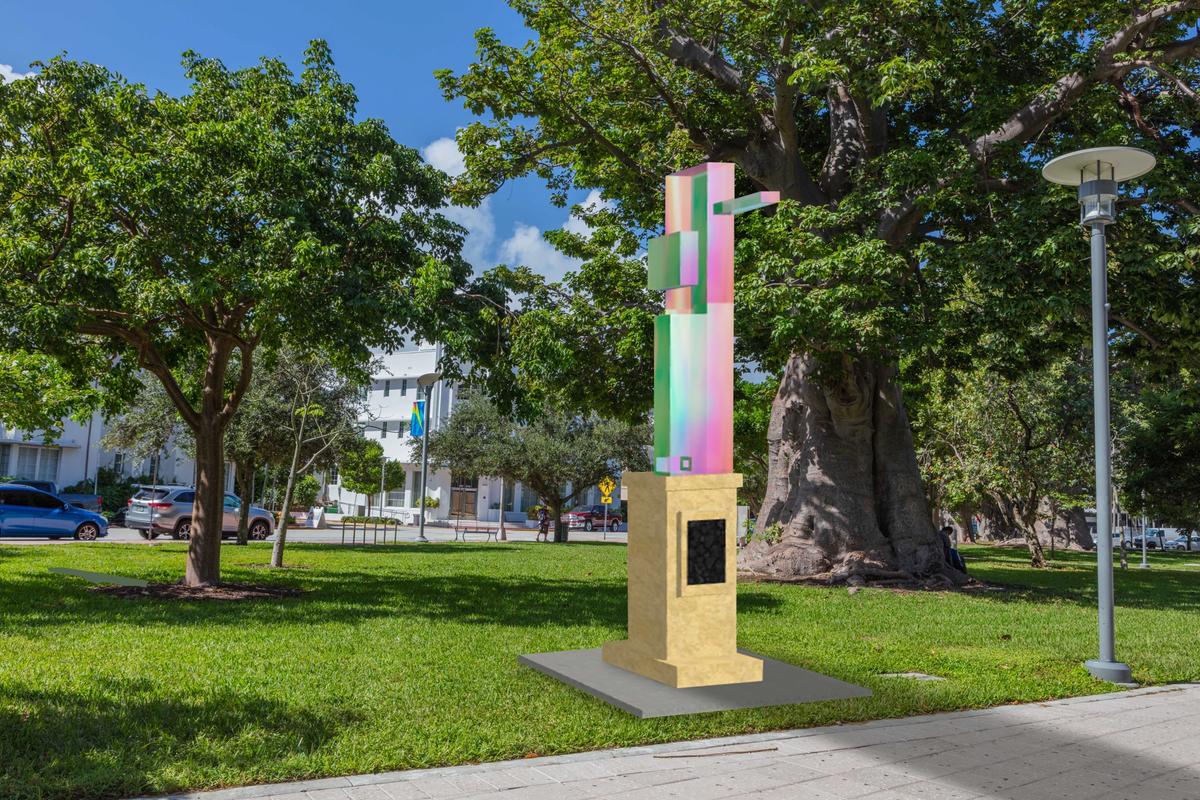In the ongoing cultural debate over what and who should be commemorated in public monuments, some new voices will join the conversation in Miami Beach come March. There, a sound shower of maternal affirmations, reminders and loving (or scolding) critiques, spoken by a chorus of women in English, Spanish and Creole, will pour out from a configuration of speakers mounted on a plinth and encased in radiant multi-toned glass in Collins Park, in front of the Bass Museum.
The installation, titled Your Mommas Voice in the Back of Your Head, was conceived by Najja Moon, the inaugural winner of the Bass Museum’s “New Monuments” commission, a five-year initiative supported by the John S. and James L. Knight Foundation. Last summer, the museum launched an open call to artists in Miami-Dade County to reimagine what kind of monument could fill a fifth plinth in Collins Park, where four permanent memorials to Latin American men already stand.
“When I thought about something that I would want to honour in a really personal way, I was like—my mom deserves a monument,” says Moon, a 33-year-old Miami-based artist whose work often explores the intersection of queer identity, the body and movement, and Black culture. “We've made our mothers monuments in our minds, whether that relationship is positive or not. I was excited to think about how universal this could be while also saying thank you to my mother.”
Moon's proposal was selected from more than 80 applications by the museum's executive director and chief curator, Silvia Karman Cubiñá, and its curator, Leilani Lynch. “Najja’s piece is a real testament to motherhood and labour that has gone under-recognised,” Lynch says. The curator is interested in how this geometrically constructed work—to remain on view until January 2022—will contrast visually with the figuration of the other monuments in the park while still reading as part of the group in its placement on a similar plinth. The museum will annually commission a piece for the pedestal by a local artist, who will receive a $5,000 honorarium in addition to production costs for the monument.
To create her piece, Moon plans to set up a couple of public recording studios in January and February—including one at the Bass. She will invite people she knows, first and foremost her own mother who is a minister, to contribute maternal phrases such as, “You can do anything you put your mind to baby” and “You’ll understand when you have kids.” Moon will also welcome passersby to drop in and chat.

Najja Moon, the 33-year-old Miami-based artist whose work often explores the intersection of queer identity, the body and movement, and Black culture Photo: GeoVanna Gonzalez
“I’m excited to sit down with folks and have conversations,” says Moon, who often works collaboratively with different communities and engages people easily with her humour and candor. “What is it that you say now that your mom used to say?” she poses. “What do you catch coming out of your mouth? What rings in the back of your head that stops you from doing what you’re not supposed to do?” She hopes to cull about 100 sound bytes to mix in the final audio for the multi-directional speakers and is interested in highlighting various colloquialisms and regionalisms.
Born and raised in Durham, North Carolina, Moon studied art at Pfeiffer University just outside Charlotte before moving to Miami in 2009. She became known in the local art community for cofounding the BLCK Family in 2015, a collective staging performance art shows centered on culinary, visual and social practices. “We were really committed to trying to build immersive environments for people to eat together and connect and for an evening feel like you were able to get transported to the world that you want to see in the future,” Moon says. She currently collaborates with her partner, GeoVanna Gonzalez, on a video series about their experiment with living in a truck called Aesthetics of Mobility.
Visually, Moon's abstract construction of speakers, rising 7ft high atop the 5ft-tall plinth, is a departure from the the kind of gestural line drawings she typically makes in her own studio practice. “This is definitely new for me aesthetically but it’s a way for me to work with my hands and still have a social-practice approach at the same time,” she says. “In terms of the visibility of this work, it’s a great next step for me.”


